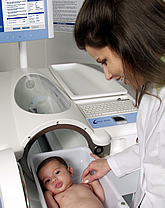This page has been archived and is being provided for reference purposes only. The page is no longer being updated, and therefore, links on the page may be invalid.
|
|
|
|
Body Composition Device Facilitates Infant Studies
By Alfredo FloresDecember 15, 2006
The accuracy of a new machine for estimating the body composition of infants has been demonstrated in a two-year study by scientists at the U.S. Department of Agriculture (USDA)-funded Children's Nutrition Research Center (CNRC) in Houston, Texas.
Nutrition researcher Ken Ellis at CNRC oversaw testing of the device--an infant-sized, air-displacement plethysmograph called the PEA POD Infant Body Composition System. It was developed by Life Measurement, Inc., of Concord, Calif.
Working with 56 healthy infants, Ellis and his team compared the readings obtained from this new, state-of-the-art device with those obtained for a reference model of infant body composition that required the use of four separate machines. The results from the new device were nearly identical, with the percentage of body fat obtained with the PEA POD falling within one percent of the expected values.
According to Ellis, the PEA POD offers key advantages to researchers. In the past, it took four separate measurements using different devices over a three- to four-hour period to accurately study changes in body fat during infancy. Now, the same information can be obtained in less than five minutes using the PEA POD.
Thanks to its ease of use and bedside accessibility, the PEA POD makes it much quicker and more convenient to monitor changes in infants' body composition as they grow. The time-saving and convenience should also make it possible to undertake more clinical studies with infants.
The CNRC is operated by Baylor College of Medicine in cooperation with Texas Children's Hospital and the Agricultural Research Service, USDA's chief scientific research agency.
This research and its potential effect on future CNRC studies is discussed in the December issue of the American Journal of Clinical Nutrition. The PEA POD device has recently been made commercially available for hospital use.

